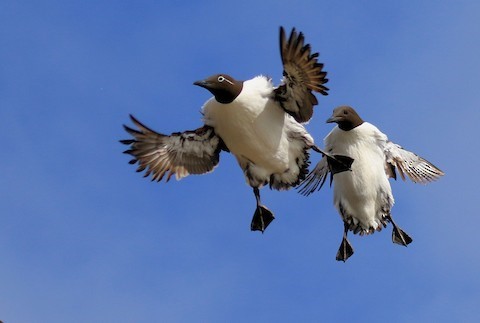Birdfinding.info ⇒ Generally common over much of its range, and locally abundant around its breeding areas, including many parts of the Pacific Coast of North America from Alaska to California, the Canadian Maritime Provinces, Iceland, and the British Isles. In the eastern U.S. it is seen regularly in winter at various seawatch points in the Northeast, including Cape Ann and Race Point, and occasionally in harbors and inlets along the New England coast.
Common Murre
Uria aalge
Breeds on coasts and islands of the North Pacific and North Atlantic Oceans, and adjacent seas; disperses to adjacent waters.

Approximate distribution of the Common Murre. © Xeno-Canto 2022
Breeding. Breeds mostly from April to August (but with wide geographic variation) in large colonies on sea cliffs and islets along the coasts of North America, Eurasia, and several arctic and subarctic islands.
In the Pacific, breeding colonies are distributed around the Bering Sea and the Sea of Okhotsk: southwest to the southern Kuril Islands and western Hokkaido (Teuri Island); east along the southern coasts and islands of Alaska, then south along the coasts of British Columbia, Washington, Oregon, and northern California; and north to the Bering Strait and Cape Lisburne.
In the western North Atlantic, breeding colonies are scattered: north to southwestern Greenland, along the coasts of Labrador and Newfoundland, the Gulf of St. Lawrence, Nova Scotia, and the Gulf of Maine.
In the eastern North Atlantic, breeding colonies are more extensive: from Iceland east to Svalbard (a few pairs), Bear Island, Finnmark, and Novaya Zemlya, south along coasts of southern Scandinavia, the Faeroes, the British Isles, Normandy, and on the Iberian Peninsula in northwestern Spain and central Portugal.

Common Murres at their breeding colony on Gull Island, Witless Bay Ecological Reserve, Newfoundland. (June 30, 2017.) © Pavel Parkhaev
The global population was estimated at 12 to 15 million pairs in the 1990s: 6.3 million in the Pacific and 6 to 9 million in the Atlantic. Regional concentrations in the Pacific were estimated at: Alaskan Bering Sea, 34%; Alaska Peninsula, 24%; Washington and Oregon, 11%; Sea of Okhotsk, 10%; Russian Bering Sea, 9%; California, 6%; and Kuril Islands, 5%. Regional concentrations in the Atlantic were estimated at: Iceland, 38%; British Isles, 19%; Bear Island, 18%; eastern Canada, 14%; Faeroes, 7%; and Norway, 3%.
Nonbreeding. Winters at sea in the North Pacific and North Atlantic, mostly remaining in the same latitudes as its breeding colonies.
In the Pacific, regular wintering areas include the southern portions of the Bering Sea and Sea of Okhotsk, south to northern Honshu and the oceanic waters along the coast of North America from the Gulf of Alaska south to northern Baja California.
In the western Atlantic, regular wintering areas extend from Labrador and the Gulf of St. Lawrence south to Massachusetts. In the northern and eastern Atlantic, winters regularly from Icelandic and Norwegian waters south to the Iberian Peninsula, and sparingly in the southern Baltic Sea.
Scattered individuals appear sporadically south to southern Japan, North Carolina, and into the western Mediterranean.
More exceptional vagrants have been recorded from South Korea, Florida, Sinaloa, and Mauritania.
Identification
A large, robust, black-and-white auk (the largest surviving alcid species) with a long, sharp-tipped, daggerlike bill.
Extremely similar in all plumages to its sibling species, the Thick-billed Murre, which occurs together with it throughout most of their ranges. (For a detailed comparison, see below.)

Common Murre in breeding plumage. (Southeast Farallon Island, California; November 6, 2020.) © Evan Lipton
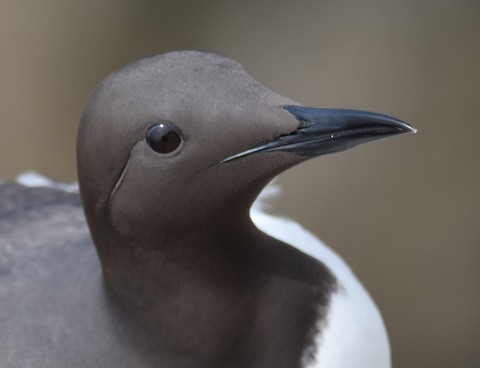
Common Murre in breeding plumage—note subtle whitish “moustache” line at the base of the bill. (Isle of May, Scotland; June 15, 2017.) © Ian Thomson
Breeding plumage is crisply defined: black (or blackish-brown) upperparts contrast with all-white underparts. This pattern is nearly identical to the Thick-billed Murre’s, except that on Thick-billed the white of the underparts projects up to an angular point on the front of the neck.
Unlike the Thick-billed Murre, Common usually has dark streaking on the side, which is most visible when it is resting on the water.
In Atlantic populations, a variable portion of the population (up to ~50% in some colonies) has a thin white eyering which continues as a thin white line through a crease in the plumage that extends from the eye back over the cheek and down toward the neck. This “bridled” morph is fully integrated with the typical, non-bridled majority.
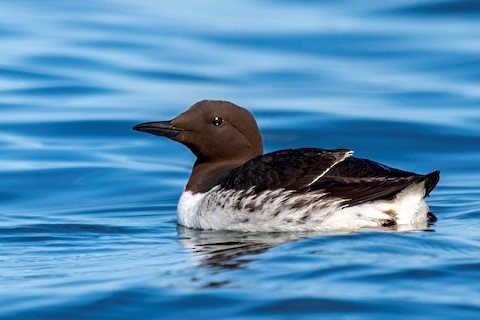
Common Murre in breeding plumage, showing extensive streaking on the sides. (Machias Seal Island, New Brunswick; July 29, 2021.) © Su Li
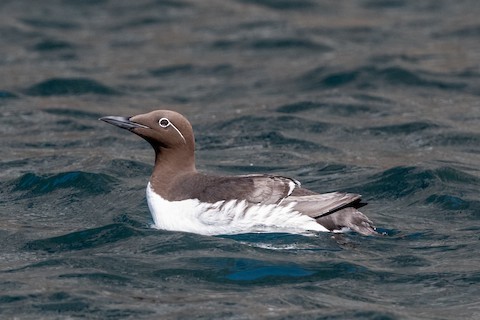
Common Murre, “bridled” morph in breeding plumage. (Runde, Møre og Romsdal, Norway; June 24, 2019.) © Hans Norelius
Nonbreeding plumage is similar to breeding, except that the neck is mostly white and the borders between white and black are somewhat blurred. The face remains mostly black, but the white of the neck extends up behind the eye forming a prominent ear-patch or partial collar across the hindcrown. The white area is usually well-defined and divided by a narrow black line that extends back from eye and curves down toward the neck.

Common Murre in nonbreeding plumage, showing distinctively crisp black line across the white cheek. (Southeast Farallon Island, California; November 7, 2020.) © Evan Lipton
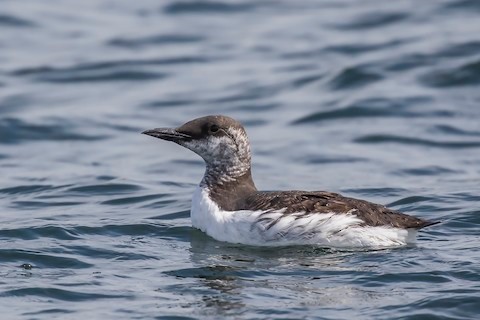
Common Murre molting into nonbreeding plumage. (Point Whitehorn Marine Reserve, Birch Bay, Washington; August 20, 2017.) © Eric Ellingson
In flight, the underside of the wing is bicolored with mostly white lesser and median coverts and darker flight feathers and greater coverts. Relative to the Thick-billed Murre, Common tends to have more black in the underwing at the base and mixed into the white of the coverts.

Common Murre in breeding plumage, ventral view in flight showing black at the base of the underwing and in the mostly white coverts. (Bjargtangar, Látrabjarg, Vestfirðir, Iceland; June 4, 2021.) © Yann Kolbeinsson

Common Murre in breeding plumage, ventral view in flight showing atypical lack of black at the base of the underwing and in the coverts. (Helgoland, Germany; July 1, 2016.) © Holger Teichmann
Notes
Polytypic species consisting of five recognized subspecies. Known in the U.K. as the Guillemot.
See below for a comparison of the Common Murre with the Thick-billed Murre.
Cf. Thick-billed Murre. Common and Thick-billed Murres are both numerous, widespread species that occur together across large portions of the North Pacific and North Atlantic, breeding in many of the same colonies, often side-by-side. They can appear nearly identical, and can be especially confusing because some of the distinctions illustrated in field guides are variable and often ambiguous on live birds.
Bill Shape: According to its name, the Thick-billed Murre presumably has a thicker bill than the Common Murre. But to the contrary, when measured in the hand, their average bill depths are almost identical. The key difference is length: Common’s bill averages about 20-30% longer than Thick-billed’s, so it appears thinner.
Bill Stripe: Thick-billed’s most conspicuous feature is the white stripe along the inner half of the cutting edge of the upper mandible—which has the appearance of a pencil-thin moustache. However, it is not always present or clearly visible on all Thick-billeds, especially immatures. Reliance on this feature for identification is also complicated by the fact that Common’s bill often shows a similar whitish stripe, but usually much thinner and fainter—a source of confusion that is rarely illustrated in field guides.
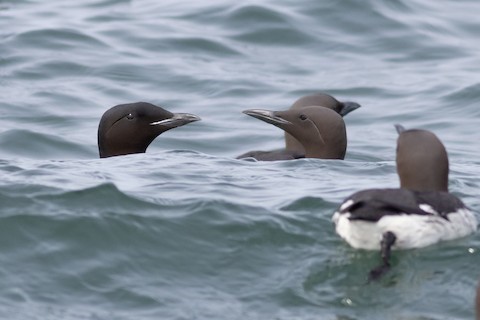
Thick-billed Murre (head only, at left) with Common Murres, enabling direct comparison of overall plumage coloration and bill and head shapes. (Kachemak Bay, Alaska; June 8, 2021.) © Tom Johnson

Thick-billed Murre in breeding plumage, showing characteristic V pattern on the neck and white “pencil-thin moustache” on the bill. (Longyearbyen, Svalbard; June 15, 2019.) © Egor Vlasov

Common Murre in breeding plumage—somewhat confusingly showing a V-like pattern on the neck and white “pencil-thin moustache” on the bill, resembling Thick-billed. (Gull Island, Witless Bay, Newfoundland; June 30, 2017.) © Pavel Parkhaev
Breeding Plumage: Common and Thick-billed Murres have essentially identical breeding plumages, with two small differences. Although both have blackish upperparts, Common is browner, Thick-billed is blacker—note that this distinction may require comparison in equivalent lighting to evaluate. The other difference is the boundary between black and white on the front of the neck, where Thick-billed typically shows an acute V. This distinction is also less consistent than field guide illustrations suggest, as Common Murre shows great variability in this feature, and it becomes especially ambiguous in some postures (when Common extends its neck, it looks more like Thick-billed, and when Thick-billed retracts its neck, it looks more like Common).
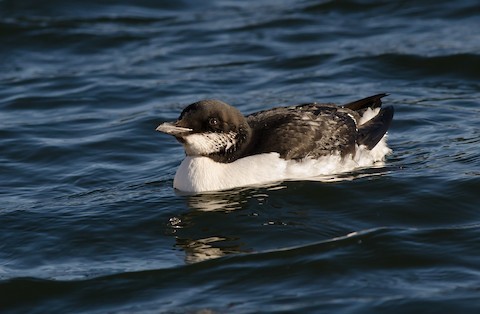
Thick-billed Murre in nonbreeding plumage—identifiable by its mostly black head and mostly white throat. (Clark’s Harbour, Nova Scotia; February 6, 2016.) © Alix d’Entremont
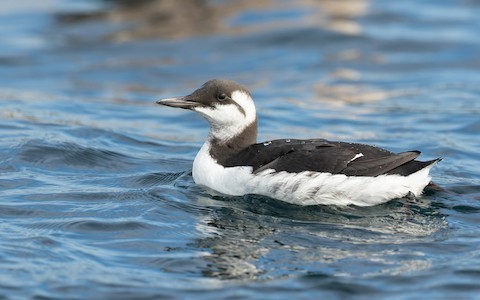
Common Murre in nonbreeding plumage—identifiable by its extensively white cheek divided by a thin black stripe. (Race Rocks, British Columbia; October 8, 2021.) © Blair Dudeck
Nonbreeding Plumage: Winter-plumaged murres are best identified by the extent of white on the head. Thick-billed’s head remains nearly all-black except for the throat, which turns whitish. In contrast, Common’s head turns mostly whitish from the throat up across the cheeks and behind the eye—the white area is divided by a bold black line that extends back from the eye and curves down toward the neck.
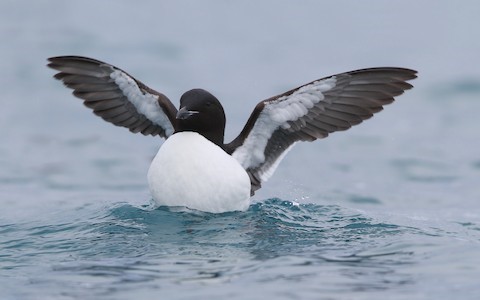
Thick-billed Murre in breeding plumage showing cleanly black-and-white underwing pattern in glare-free lighting. (Lilliehöökbreen, Nordvest-Spitsbergen National Park, Svalbard; June 11, 2015.) © Christoph Moning
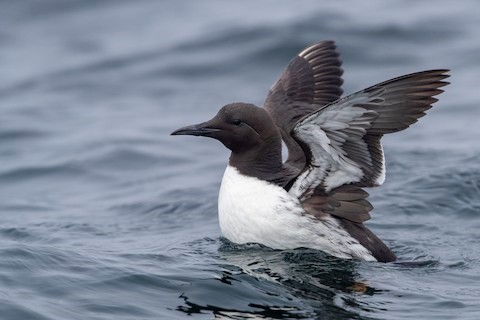
Common Murre in breeding plumage, showing black axillaries, black mixed into the underwing coverts, and dark streaks on the sides. (Iony Island, Habarovskij Kraj, Russia; June 12, 2016.) © Michael Stubblefield
Flank Pattern: In all plumages, Thick-billed has essentially all-white flanks, sometimes with a few subtle dark lines, whereas Common more typically shows broad, dusky streaks on its flanks. The streaks seem to be strongest in nonbreeding plumages and most noticeable when resting on the water.
Underwing Pattern: Thick-billed Murre’s underwings are evenly two-toned: white on the lesser and median coverts and dark on the flight feathers and greater coverts. Common’s underwings are similar but tend to show more black at the hinge (i.e., the axillaries), and usually a blackish strip that disrupts the white coverts.
More Images of the Common Murre

Common Murre in breeding plumage. (Southeast Farallon Island, California; July 25, 2020.) © Hallie Daly

Common Murre, “bridled” morph in breeding plumage. (Offshore from Saguenay, Quebec; June 9, 2019.) © André Lanouette
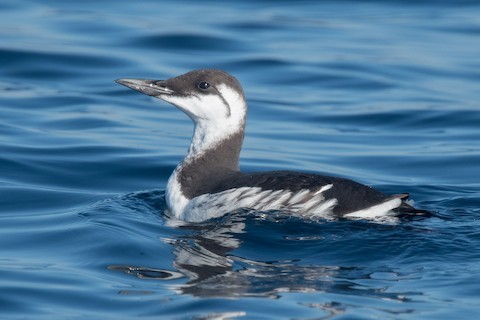
Common Murre in nonbreeding plumage, showing extensive streaking on the flanks. (Lower Nine-Mile Bank, California; December 12, 2021.) © Nancy Christensen
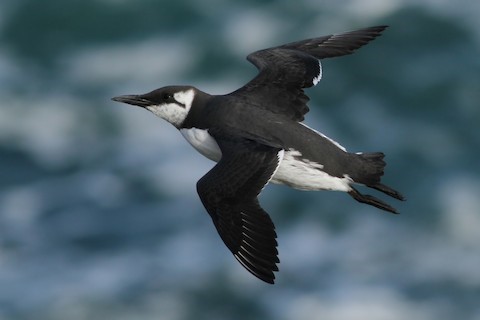
Common Murre in nonbreeding plumage, dorsal view in flight. (Southeast Farallon Island, California; November 6, 2020.) © Evan Lipton

Common Murre in nonbreeding plumage, ventral view in flight. (Gdańsk Bay, Poland; January 8, 2022.) © Marcin Dyduch
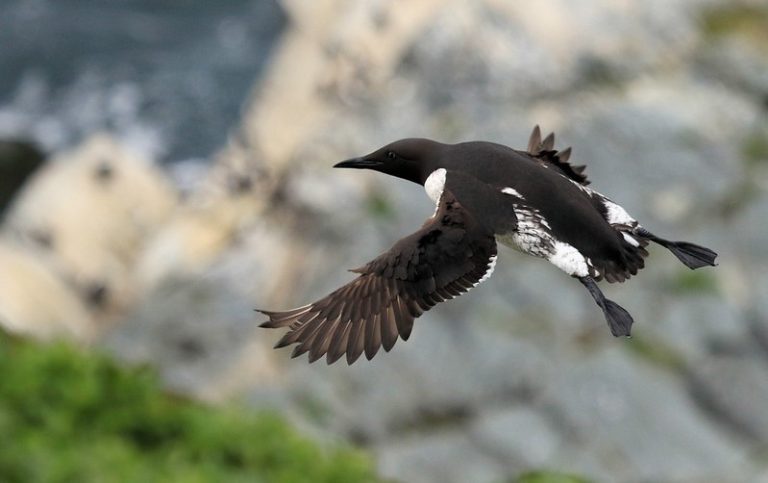
Common Murre in breeding plumage, dorsal view in flight. (Hornøya, Vardø, Finnmark, Norway; May 29, 2015.) © Patrick Monney
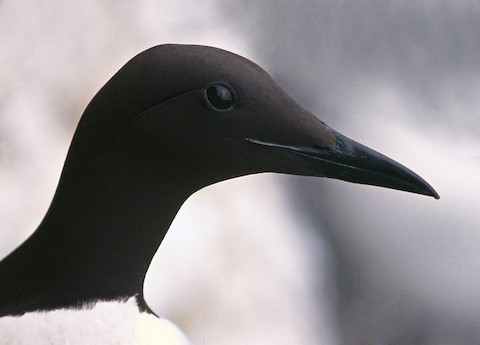
Common Murre in breeding plumage—note subtle whitish “moustache” line at the base of the bill. (Fowlsheugh RSPB Reserve, Scotland; May 26, 2001.) © Tamas Zeke

Common Murre in nonbreeding plumage. (Southeast Farallon Island, California; November 6, 2020.) © Evan Lipton
References
Alderfer, J., and J.L. Dunn. 2014. National Geographic Complete Birds of North America (Second Edition). National Geographic Society, Washington, D.C.
BirdLife International. 2018. Uria aalge. The IUCN Red List of Threatened Species 2018: e.T22694841A132577296. https://dx.doi.org/10.2305/IUCN.UK.2018-2.RLTS.T22694841A132577296.en. (Accessed March 5, 2022.)
Brazil, M. 2009. Birds of East Asia. Princeton University Press.
eBird. 2022. eBird: An online database of bird distribution and abundance. Cornell Lab of Ornithology, Ithaca, N.Y. http://www.ebird.org. (Accessed March 5, 2022.)
Gaston, A.J., and I.L. Jones. 1998. The Auks: Alcidae. Oxford University Press.
Harrison, P. 1983. Seabirds: An Identification Guide. Houghton Mifflin, Boston.
Howell, S.N.G., and K. Zufelt. 2019. Oceanic Birds of the World. Princeton University Press.
Sibley, D.A. 2014. The Sibley Guide to Birds (Second Edition). Alfred A. Knopf. New York.
Svensson, L., K. Mullarney, and D. Zetterström. 2009. Birds of Europe (Second Edition). Princeton University Press.
Xeno-Canto. 2022. Common Murre – Uria aalge. https://xeno-canto.org/species/Uria-aalge. (Accessed March 5, 2022.)

